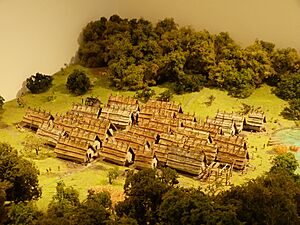Pfyn culture facts for kids
| Geographical range | Southern Germany (Oberschwaben and southern Bavaria) and Switzerland near Lake Constance. |
|---|---|
| Period | Neolithic, Chalcolithic |
| Dates | 4,300–3,500 BC |
| Characteristics | lake shore settlements pig domestication |
| Preceded by | Rössen culture, Michelsberg culture |
| Followed by | Horgen culture |
The Pfyn Culture was an ancient group of people living in parts of Switzerland and southern Germany. They lived during the Neolithic period, also known as the New Stone Age. This culture existed from about 4300 BC to 3500 BC. People of the Pfyn Culture were known for their unique way of life and how they built their homes.
Contents
Discovering the Pfyn Culture
The first signs of a Pfyn Culture settlement were found near the town of Pfyn in Switzerland. This area was once a peat bog, which is a type of wetland. The site, called Breitenloo, was first discovered in the late 1800s. However, people forgot about it for a while.
During World War II, in the 1940s, people tried to drain the bog to create more farmland. This led to the settlement being found again. In 1944, Polish soldiers, who were interned (held) in the area, helped dig up a large part of the site. They worked under the guidance of Charles Keller-Tarnuzzer. Experts believe that about 60% of the ancient village has been explored.
What Did Pfyn Houses Look Like?
During the 1944 dig, archaeologists found the remains of 17 different houses. These homes were built along a main street that ran north to south. Their front walls, called gables, faced the street. Most houses had two main sections inside and were rectangular. They were usually between 4 and 11 meters (13 to 36 feet) long and 3.5 to 5.5 meters (11 to 18 feet) wide.
It was interesting that houses of very different sizes were built next to each other. This might mean that some larger buildings were homes, while smaller ones were used for farming or storage. The floors of these houses were built on strong support structures. They had split wooden boards on top, often covered with clay. Some signs suggest that at least some buildings were raised high off the ground.
How We Learned About Pfyn Culture
At first, researchers thought the pottery found at Pfyn was similar to another culture called the Michelsberg culture from southern Germany. They believed Pfyn was just a Michelsberg settlement. But around 1960, more research showed that the pottery from Pfyn was unique. It was related to Michelsberg, but it was its own distinct style.
Since then, the Pfyn-Breitenloo site has been seen as the main place for understanding the Pfyn Culture. Later studies in 2002 and 2004 helped scientists learn even more. They used a method called dendrochronology to date the wood used in the houses. This method counts tree rings to find the exact year a tree was cut. They found that the wood was cut between 3706 and 3704 BC. This confirmed that the settlement was built in one main period. Another Pfyn settlement might have existed nearby, but it was likely destroyed by peat mining.
How the Pfyn People Lived
The Pfyn Culture people had a varied economy, meaning they used different ways to get food and resources.
Farming and Food
Growing crops was very important to the Pfyn people. At Pfyn sites near Zurich, archaeologists found a lot of Durum wheat and Barley. It's estimated that about half of the food calories eaten by the Pfyn people came from these grains.
Raising animals was also a big part of their lives. They were especially known for raising many pigs. This "pig economy" became very common during the Pfyn Culture. Later, other cultures like the Horgen culture and Corded Ware cultures also adopted this practice.
Early Metal Use
Some evidence of metalworking has been found in the area where the Pfyn Culture lived. This includes the region between Lake Constance and Lake Zürich. Most of these metal pieces were found alone, making it hard to know their exact age. However, a copper wire and a dagger from the Pfyn era were found at a place called Reute. They also found special pots called crucibles and metal spills, which are signs of metal being melted and shaped.
Where Did the Pfyn Culture Live?
Archaeologists have found Pfyn Culture sites in several places in eastern Switzerland. Some of the important sites include:
- Breitenloo: This site is about 1.5 kilometers (0.9 miles) from Pfyn in the canton of Thurgau, near the Thur river.
- Feldmeilen-Vorderfeld and Meilen: These sites are located on the right bank of Lake Zurich. At Feldmeilen, experts found four layers of Pfyn Culture items, dating from 4350-3950 BC. After these, they found five layers from the later Horgen culture. In Meilen, one Pfyn layer (4250-4000 BC) was found, followed by three Horgen layers.
Images for kids
See also
- Prehistoric pile dwellings around the Alps




